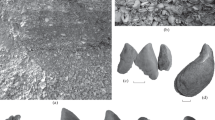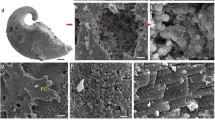Abstract
Use is made of the argon ion-bombardment technique to reduce the thickness of calcium carbonate shells of the bivalvesMytilus andMercenaria for transmission electron microscopy and electron diffraction, with comparison of single-stage replicas of similar specimens serving as controls. As an additional approach to shell structure studies, it gives results which support earlier published work with both replicas and scanning microscopy. In addition, a “frothy” structure is detected in the shell aragonites, especially inMytilus nacre. As a heat-induced artifact, it is interpreted as representing trapped water and organic material inclusions, an interpretation consistent with several published chemical and electron microscope studies.
Résumé
La technique du bombardement à l'aide d'ion d'argon est utilisée pour réduire l'épaisseur de la coquille de carbonate de calcium des bivalvesMytilus etMercenaria pour examen au microscope électronique par transmission et en diffraction électronique; une comparaison est réalisée à l'aide de répliques simples, servant de témoins. Les résultats obtenus confirment les études antérieures de répliques et de microscopie par balayage. De plus, une structure “aérée” est mise en évidence dans la coquille des aragonites, et surtout dans le nacre deMytilus. Cette structure est interprêtée comme un artefact induit par la chaleur, formé par l'inclusion d'eau et de matériel organique, interprétation qui concorde avec les études chimiques et de microscopie électronique.
Zusammenfassung
Die Beschießung mit Argonionen wurde angewendet, um die Dicke von Calciumcarbonat-Schalen der zweischaligen MuschelnMytilus undMercenaria zu reduzieren. Diese Technik erlaubte die Ausführung von Transmissions-Elektronenmikroskopie und Elektronendiffraktion, wobei gleiche Proben nach einer bereits bestehenden Methode vorbereitet und als Kontrollen herangezogen wurden. Es wurden zusätzliche Resultate zu den Muschelstruktur-studien erhalten, welche früher publizierte Arbeiten unterstützen, die mit der Abklatschmethode und der Raster-Elektronenmikroskopie ausgeführt worden waren. Zusätzlich wurde eine „schaumartige” Struktur der Muschelaragoniten, besonders im Perlmutter vonMytilus, beobachtet. Da es sich um ein durch Hitze verursachtes Artefakt handelt, wird diese Struktur als Einschlüsse von Wasser und organischem Material interpretiert, was den Befunden von verschiedenen veröffentlichten chemischen und elektronenmikroskopischen Arbeiten entspricht.
Similar content being viewed by others
References
Barber, D. J.: Thin foils of non-metals made for electron microscopy by sputter-etching. J. Materials Sci.5, 1–8 (1970).
Carlström, D., Glas, J. E., Angmar, B.: Studies on the ultrastructure of human enamel-V. The state of water in human enamel. J. Ultrastruct. Res.8, 24–29 (1963).
Crenshaw, M. A.: The soluble matrix fromMercenaria mercenaria shell. Abstracts, Mainz Intern. Sympos. Biomineralization, p. 38, 1970.
Crenshaw, M. A.: The soluble matrix fromMercenaria mercenaria shell. Biomineralisation Res. Repts. (in press).
Genty, B.: Ionic impact thinning of metallic samples to be examined by electron microscope. In: J. J. Trillat, ed., ionic bombardment, theory and applications, p. 142–160. New York: Gordon & Breach 1962.
Heuer, A. H., Firestone, R. F., Snow, J. D., Green, H. W., Howe, R. G.: An improved ion thinning apparatus. Rev. Sci. Instruments42, 1177–1184 (1971).
Hudson, J. D.: The elemental composition of the organic fraction, and the water content of some recent and fossil mollusc shells. Geochim. Cosmochim. Acta31, 2361–2378 (1967).
Hudson, J. D.: The microstructure and mineralogy of the shell of a Jurassic mytilid (Bivalvia). Palaeontology11, 163–182 (1968).
Inman, M. D.: Transmission electron microscopy of terrestrial rocks and minerals. In: C. J. Arceneaux, ed., Proc. 28th Ann. Mtg. Electron Microscope Soc. America, p. 486–487. Baton Rouge: Claitors Publ. 1970.
Little, M. F., Casciani, F. S.: The nature of water in sound human enamel, a preliminary study. Arch. oral Biol.11, 565–571 (1966).
Mutvei, H.: Ultrastructure of the mineral and organic components of molluscan nacreous layers. Biomineralization Res. Repts.2, 49–72 (1970).
Myers, H. M.: Trapped water of dental enamel. Nature (Lond.)206, 713–714 (1965).
Nakahara, H., Bevelander, G.: An electron microscope study of the muscle attachment in the molluscPinctada radiata. Texas Rep. Biol. Med.28, 279–286 (1970).
Newesely, H., Helmcke, J.-G.: Dünnschnittpräparation kompakter Kristalle und mineralisierter Hartgewebe für Röntgenfluoreszenz-Analysen mit dem Elektronenmikroskop (Elmiskopsonde). Biomineralization Res. Repts.3, 39–50 (1971).
Nickl, H. J., Henisch, H. K.: Growth of calcite crystals in gels. J Electrochem. Soc.116, 1258–1260 (1969).
Paulus, M., Reverchon, F.: Study of the parameters of the ionic bombardment of ferrites: Application to the thinning at almost grazing incidence of porous materials. In: J. J. Trillat, ed. ionic bombardment, theory and applications, p. 324–338. New York: Gordon and Breach 1962.
Sjöstrand, F. S.: Electron microscopy of cells and tissues, vol. 1, p. 113. New York: Academic Press 1967.
Tighe, N. J.: Observations in polycrystalline ceramics by electron transmission microscopy. In: C. J. Arceneaux, ed. Proc. 26th Ann. Mtg. Electron Microscope Soc. America, p. 420–421. Baton Rouge: Claitors Publ. 1968.
Towe, K. M.: Invertebrate shell structure and the organic matrix concept. Biomineralization Res. Repts.4, 1–14 (1972).
Towe, K. M., Hamilton, G. H.: Ultramicrotome-induced deformation artifacts in densely calcified material. J. Ultrastruct. Res.22, 274–281 (1968).
Travis, D. F.: The structure and organization of, and the relationship between, the inorganic crystals and the organic matrix of the prismatic region ofMytilus edulis. J. Ultrastruct. Res.23, 183–215 (1968).
Travis, D. F., Gonsalves, M.: Comparative ultrastructure and organization of the prismatic region of two bivalves and its possible relation to the chemical mechanism of boring. Amer. Zoologist9, 635–661 (1969).
Wada, K.: Crystal growth of molluscan shells. Bull. Nat. Pearl Res. Lab.7, 703–828 (1961).
Watabe, N.: Studies on shell formation. XI. Crystal-matrix relationships in the inner layers of mollusk shells. J. Ultrastruct. Res.12, 351–370 (1965).
Wise, S. W. Jr.: Study of molluscan shell ultrastructures. In: O. Johari, ed. Proc. 2nd Ann. Scanning Elect. Microsc. Sympos., p. 205–216. Chicago: IIT Research Inst. 1969.
Author information
Authors and Affiliations
Rights and permissions
About this article
Cite this article
Towe, K.M., Thompson, G.R. The structure of some bivalve shell carbonates prepared by ion-beam thinning. Calc. Tis Res. 10, 38–48 (1972). https://doi.org/10.1007/BF02012534
Received:
Accepted:
Issue Date:
DOI: https://doi.org/10.1007/BF02012534




